Sakha,[a] officially the Republic of Sakha (Yakutia),[b] is the largest republic of Russia, located in the Russian Far East, along the Arctic Ocean, with a population of one million.[10] Sakha comprises half of the area of its governing Far Eastern Federal District, and is the world's largest country subdivision, covering over 3,083,523 square kilometers (1,190,555 sq mi).[11] Yakutsk, which is the world's coldest major city,[12] is its capital and largest city.
Republic of Sakha (Yakutia) | |
|---|---|
| Республика Саха (Якутия) | |
| Other transcription(s) | |
| • Yakut | Саха Өрөспүүбүлүкэтэ |
| • Romanization | Saxa Öröspüübülükete |
| Anthem: "State Anthem of the Sakha Republic" | |
 | |
| Coordinates: 66°24′N 129°10′E / 66.400°N 129.167°E | |
| Country | Russia |
| Federal district | Far Eastern[1] |
| Economic region | Far Eastern[2] |
| Capital | Yakutsk[3] |
| Government | |
| • Body | State Assembly (Il Tumen)[4] |
| • Head[4] | Aysen Nikolayev |
| Area | |
| • Total | 3,083,523 km2 (1,190,555 sq mi) |
| • Rank | 1st |
| Population | |
| • Total | 995,686 |
| • Estimate (2018)[7] | 964,330 |
| • Rank | 50th |
| • Density | 0.32/km2 (0.84/sq mi) |
| • Urban | 66.8% |
| • Rural | 33.2% |
| Time zones | |
| most (excluding districts in UTC+10:00 and UTC+11:00 time zones) | UTC+09:00 (Yakutsk Time) |
| Oymyakonsky, Ust-Yansky and Verkhoyansky districts | UTC+10:00 (Vladivostok Time) |
| Abyysky, Allaikhovsky, Momsky, Nizhnekolymsky, Srednekolymsky and Verkhnekolymsky districts | UTC+11:00 (Magadan Time) |
| ISO 3166 code | RU-SA |
| License plates | 14 |
| OKTMO ID | 98000000 |
| Official languages | Russian;[8] Yakut[9] |
| Website | sakha |
The republic has a reputation for an extreme and severe climate, with the second lowest temperatures in the Northern Hemisphere being recorded in Verkhoyansk and Oymyakon (second only to Summit Camp, Greenland), and regular winter averages commonly dipping below −35 °C (−31 °F) in Yakutsk. The hypercontinental tendencies also result in warm summers for much of the republic.
Sakha was first home to hunting-gathering and reindeer herding Tungusic and Paleosiberian peoples such as the Evenks and Yukaghir. Migrating from the area around Lake Baikal, the Turkic Sakha people first settled along the middle Lena river sometime between the 9th and 16th centuries, likely in several waves, bringing the pastoral economic system of Central Asia with them.
The Russians colonised and incorporated the area as Yakutsk Oblast into the Tsardom of Russia in the early-mid 17th century, obliging the indigenous peoples of the area to pay fur tribute. While the initial period following the Russian conquest saw the Sakha population drop by 70%, the Imperial period also saw the expansion of the native Yakuts from the middle Lena along the Vilyuy River to the north and the east displacing other indigenous groups. Yakutia saw some of the last battles of the Russian Civil War, and the Bolshevik authorities re-organized Yakutsk Oblast into the autonomous Yakut ASSR in 1922. The Soviet era saw the migration of many Slavs, specifically Russians and Ukrainians, into the area.
On 27 September 1990, the area became the Yakutskaya-Sakha Soviet Socialist Republic, and on 27 December 1991, it became the Republic of Sakha (Yakutia).
Etymology edit
The exonym Yakut comes from the Evenk term Yako (also yoqo, ñoqa, or ñoka), which was the term the Evenks used to describe the Sakha. This was in turn picked up by the Russians.[13] The Yukaghirs, another neighboring people in Siberia, use the exonym yoqol ~ yoqod- ~ yoqon- (Tundra Yukaghir) or yaqal ~ yaqad- ~ yaqan- (Kolyma Yukaghir). [citation needed]
The self-designation Sakha is probably of the same origin (*jaqa > Sakha following regular sound changes in the course of development of the Yakut language) as the Evenk and Yukaghir exonyms for the Yakuts.[14] It is pronounced as Haka by the Dolgans, whose language is a close relative of the Yakut language.[15][16]
Geography edit

- Borders:
- internal: Chukotka Autonomous Okrug (660 km) (East and Northeast), Magadan Oblast (1520 km) (East), Khabarovsk Krai (2130 km) (Southeast), Amur Oblast (South), Zabaykalsky Krai (South), Irkutsk Oblast (South and Southwest), Krasnoyarsk Krai (West).
- water: Arctic Ocean (including Laptev Sea and Eastern Siberian Sea) (North).
- Highest point: Peak Pobeda (3,003 m), Mus-Khaya Mountain Peak (2959 m or 3,011 m)
- Maximum N–S distance: 2,500 km (1,600 mi)
- Maximum E–W distance: 2,000 km (1,200 mi)
Sakha stretches to the Henrietta Island in the far north and is washed by the Laptev and Eastern Siberian Seas of the Arctic Ocean. These waters, the coldest and iciest of all seas in the Northern Hemisphere, are covered by ice for 9–10 months of the year. New Siberian Islands are a part of the republic's territory. After Nunavut was separated from Canada's Northwest Territories in 1999, Sakha became the largest subnational entity (statoid) in the world, with an area of 3,083,523 square kilometers (1,190,555 sq mi),[11] slightly smaller than the territory of India (3.3 million km2), but still slightly larger than Argentina.
Sakha can be divided into three great vegetation belts. About 40% of Sakha lies above the Arctic circle and all of it is covered by permafrost which greatly influences the region's ecology and limits forests in the southern region. Arctic and subarctic tundra define the middle region, where lichen and moss grow as great green carpets and are favorite pastures for reindeer. In the southern part of the tundra belt, scattered stands of dwarf Siberian pine and larch grow along the rivers. Below the tundra is the vast taiga forest region. Larch trees dominate in the north and stands of fir and pine begin to appear in the south. Taiga forests cover about 47% of Sakha and almost 90% of the cover is larch.
The Sakha Republic is the site of Pleistocene Park, a project directed at recreating Pleistocene tundra grasslands by stimulating the growth of grass with the introduction of animals which thrived in the region during the late Pleistocene – early Holocene period.
Time zones edit

| Yakutsk Time | UTC+09:00 |
| Vladivostok Time | UTC+10:00 |
| Magadan Time | UTC+11:00 |
Sakha is the only federal subject of Russia which uses more than one time zone. Sakha spans three time zones.[17] Like the rest of Russia, it does not use daylight saving time.
| Map | Time zone | Abbr. | UTC offset | Areas |
|---|---|---|---|---|
 | Yakutsk Time | YAKT | UTC+09:00 | Most of the republic's territory |
 | Vladivostok Time | VLAT | UTC+10:00 | Districts of Oymyakonsky, Ust-Yansky and Verkhoyansky |
 | Magadan Time | MAGT | UTC+11:00 | Districts of Abyysky, Allaikhovsky, Momsky, Nizhnekolymsky, Srednekolymsky and Verkhnekolymsky |
Rivers edit



The largest river is the navigable Lena River (4,400 km). As it moves northward, it includes hundreds of small tributaries located in the Verkhoyansk Range.
- Lena River
- Vilyuy River (2,650 km) Lena River tributary
- Markha River (1,181 km) Vilyuy River tributary
- Morkoka River (812 km) Markha River tributary
- Tyung River (1,092 km) Vilyuy River tributary
- Markha River (1,181 km) Vilyuy River tributary
- Aldan River (2,273 km) Lena River tributary
- Amga River (1,462 km) Aldan River tributary
- Maya River (1,053 km) Aldan River tributary
- Uchur River (812 km) Aldan River tributary
- Olyokma River (1,320 km) Lena River tributary
- Linde River (804 km) Lena River tributary
- Nyuya River (798 km) Lena River tributary
- Vilyuy River (2,650 km) Lena River tributary
- Olenyok River (2,292 km)
- Kolyma River (2,129 km)
- Indigirka River (1,726 km)
- Selennyakh River (796 km) Indigirka River tributary
- Alazeya River (1,590 km)
- Anabar River (939 km)
- Yana River (872 km)
- Adycha River (715 km) Yana River tributary
- Oldzho River (330 km) Yana River tributary
- Bytantay River (620 km) Yana River tributary
Lakes edit
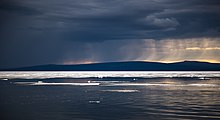
There are over 800,000 lakes in the republic.[18] Major lakes and reservoirs include:
- Lake Bolshoye Morskoye
- Lake Bustakh
- Emanda
- Lake Mogotoyevo
- Nedzheli
- Lake Nerpichye
- Lake Ozhogino
- Lake Suturuokha
- Tabanda
- Ulakhan-Kyuel
- Vilyuy Reservoir
Mountains edit
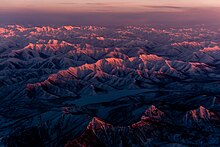
Sakha's greatest mountain range, the Verkhoyansk Range, runs parallel and east of the Lena River, forming a great arc that begins in the Sea of Okhotsk and ends in the Laptev Sea.
The Chersky Range runs east of the Verkhoyansk Range and has the highest peak in Sakha, Peak Pobeda (3,147 m). The second highest peak is Peak Mus-Khaya reaching 3,011 m.
The Stanovoy Range borders Sakha in the south.
Peninsulas edit
The Republic's extensive coastline contains a number of peninsulas; from west to east the most prominent are:
- Uryung-Tumus Peninsula
- Nordvik Peninsula
- Terpyay-Tumsa Peninsula
- Bykovsky Peninsula
- Buor-Khaya Peninsula
- Manyko Peninsula
- Shirokostan Peninsula
- Merkushina Strelka Peninsula
- Lopatka Peninsula
- Dogukan Peninsula
Islands edit
From west to east the main islands of Sakha are:
- Preobrazheniya Island
- Bolshoy Begichev Island
- Maliy Begichev Island
- Peschany Island
- Salkay Island
- Orto Ary
- Daldalakh
- Dyangylakh Island
- Dunay Islands
- Leykina Island
- Islands of the Lena Delta
- Brusneva Island
- Muostakh Island
- Ulakhan Ary Island
- Yarok Island
- Shelonsky Islands
- Makar Island
- Stolbovoy Island
- New Siberian Islands (by far the largest group)
- De Long Islands
- Medvezhyi Islands
- Kolesovsky Island
- Kolesovskaya Otmel
- Gabyshevskiy Island
- Kamenka Island
- Markhayanovskiy Island
- Gusmp Island
- Sukhanyy Island
Natural resources edit

Sakha is well endowed with raw materials. The soil contains large reserves of oil, gas, coal, diamonds, gold, silver, tin, tungsten and many others. Sakha produces 99% of all Russian diamonds and over 25% of the diamonds mined in the world.[19][20]
Climate edit
Sakha is known for its climate extremes, with the Verkhoyansk Range being the coldest area in the Northern Hemisphere. Some of the lowest natural temperatures ever recorded have been here. The Northern Hemisphere's Pole of Cold is at Verkhoyansk, where the temperatures reached as low as −67.8 °C (−90.0 °F) in 1892 and 1885, and at Oymyakon, where the temperatures reached as low as −67.8 °C (−90.0 °F) in February 1934.
| City | July (°C) | July (°F) | January (°C) | January (°F) |
|---|---|---|---|---|
| Aldan | 22.6/10.9 | 72.7/51.6 | −21.9/−30.6 | −7.4/−23.1 |
| Neryungri | 21.8/10.9 | 71.24/51.62 | −26.8/−33.9 | −16.24/−29.02 |
| Olyokminsk | 24.9/12 | 76.8/53.6 | −26.2/−34.6 | −15.2/−30.28 |
| Oymyakon | 22.7/6.1 | 72.9/43 | −42.5/−50 | −44.5/−58 |
| Verkhoyansk | 23.5/9.7 | 74.3/49.5 | −42.4/−48.3 | −44.3/−54.9 |
| Yakutsk | 25.5/12.7 | 78/54.9 | −35.1/−41.5 | −31.2/−42.7 |
| Saskylakh | 16.8/7.7 | 62.2/45.9 | −29.2/−36.7 | −20.6/−34.1 |
| Tiksi | 12.1/3.9 | 53.8/39 | −26.7/−33.8 | −16.1/−28.8 |
Average annual precipitation: 200 mm (central parts) to 700 mm (mountains of Eastern Sakha).
Administrative divisions edit
History edit
This section needs additional citations for verification. (March 2010) |
Pre-history edit

Siberia, and particularly Sakha, is of paleontological significance, as it contains bodies of prehistoric animals from the Pleistocene Epoch, preserved in ice or permafrost. In 2015, the frozen bodies of Dina and Uyan the cave lion cubs were found. Bodies of Yuka and another woolly mammoth from Oymyakon, a woolly rhinoceros from the Kolyma River, and bison and horses from Yukagir have also been found.[25] In June 2019, the severed yet preserved head of a large wolf from the Pleistocene, dated to over 40,000 years ago, was found close to the Tirekhtyakh River.[26][27][28]
Ymyakhtakh culture (c. 2200–1300 BC) was a Late Neolithic culture of Siberia, with a very large archaeological horizon. Its origins were in Sakha, in the Lena river basin. From there it spread both to the east and to the west.[29]
Early history edit
The Turkic Sakha people or Yakuts may have settled the area as early as the 9th century or as late as the 16th century, though most likely there were several migrations. They migrated up north from around Lake Baikal to the middle Lena due to pressure by the Buryats, a Mongolic group.[30]
The Sakha displaced earlier, much smaller populations who lived on hunting and reindeer herding, introducing the pastoralist economy of Central Asia. The indigenous populations of Paleosiberian and Tungusic stockwere mostly assimilated to the Sakha by the 17th century.[31]
Russian conquest edit
The Tsardom of Russia began its conquest of the region in the 17th century, moving east after the defeat of the Khanate of Sibir. Tygyn, a king of the Khangalassky Sakha, granted territory for Russian settlement in return for a military pact that included war against indigenous rebels of all North Eastern Asia (Magadan, Chukotka, Kamchatka and Sakhalin). Kull, a king of the Megino-Khangalassky Sakha, began a Sakha conspiracy by allowing the first stockade construction.[citation needed]
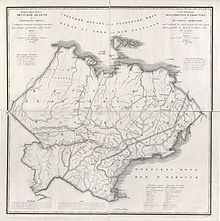
In August 1638, the Moscow Government formed a new administrative unit with the administrative center of Lensky Ostrog (Fort Lensky), the future city of Yakutsk, which had been founded by Pyotr Beketov in 1632.
The arrival of Russian settlers at the remote Russkoye Ustye in the Indigirka delta is also believed to date from the 17th century.[32] The Siberian Governorate was established as part of the Russian Empire in 1708.
Russian settlers began to form a community in the 18th century, which adopted certain Sakha customs and was often called Yakutyane (Якутя́не) or Lena Early Settlers (ленские старожилы). However, the influx of later settlers had assimilated themselves into the Russian mainstream by the 20th century.
Russian Empire edit
In an administrative reform of 1782, Irkutsk Governorate was created. In 1805, Yakutsk Oblast was split from Irkutsk Governorate.[33]
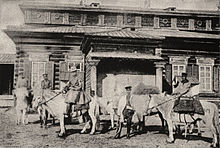
Yakutsk Oblast in the early 19th century marked the easternmost territory of the Russian Empire, including such Far Eastern (Pacific) territories as were acquired, known as Okhotsk Okrug within Yakutsk Oblast. With the formation of Primorskaya Oblast in 1856, the Russian territories of the Pacific were detached from Sakha.

The Russians established agriculture in the Lena River basin. The members of religious groups who were exiled to Sakha in the second half of the 19th century began to grow wheat, oats, and potatoes. The fur trade established a cash economy. Industry and transport began to develop at the end of the 19th century and in the beginning of the Soviet period. This was also the beginning of geological prospecting, mining, and local lead production. The first steam-powered ships and barges arrived.
Sakha's remoteness, compared to the rest of Siberia, made it a place of exile of choice for both Tsarist and Communist governments of Russia. Among the famous Tsarist-era exiles were the democratic writer Nikolay Chernyshevsky; Doukhobors, conscientious objectors whose story was told to Leo Tolstoy by Vasily Pozdnyakov; the Socialist Revolutionary Party member and writer Vladimir Zenzinov, who left an account of his Arctic experiences; and Polish socialist activist Wacław Sieroszewski, who pioneered in ethnographic research on the Sakha people.
A Sakha national movement first emerged during the 1905 Revolution. A Yakut Union was formed under the leadership of a Sakha lawyer and city councilor by the name of Vasily Nikiforov, which criticized the policies and effects of Russian colonialism, and demanded representation in the State Duma. The Yakut Union acted to make the city council of Yakutsk stand down and was joined by thousands of Sakha from the countryside, but the leaders were arrested and the movement fizzled out by April 1906. Their demand for a Sakha representative in the Duma, however, was granted.[34]
Soviet era edit
Sakha was home to the last stage of the Russian Civil War, the Yakut Revolt. On April 27, 1922, former Yakutsk Oblast was proclaimed the Yakut ASSR, although in fact the eastern part of the territory, including the city of Yakutsk, was controlled by the White Russians.

The early Soviet period saw a flourishing of Sakha literature as men such as Platon Oyunsky wrote down in writing the traditionally oral and improvised olonkho, in addition to composing their own works. Many early Sakha leaders, including Oyunsky, died in the Great Purge.
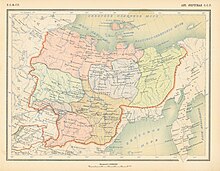
Sakha experienced significant collectivization between 1929 and 1934, with the number of households experiencing collectivization rising from 3.6% in 1929 to 41.7% in 1932. Policies by which the Sakha were harshly affected resulted in the population dropping from 240,500 in 1926 down to 236,700 at the 1959 census.[35]
Sakha's demographics shifted wildly during the Soviet period as ethnic Russians and Ukrainians, among other groups, settled the area en masse, primarily in Yakutsk and the industrial south. Previously, even Yakutsk had been primarily Sakha and Sakha-speaking. With the end of korenizatsiya, usage of the Sakha language was restricted in urban areas such as Yakutsk, which became primarily Russian-speaking.
Post-Soviet era edit
In 1992, after the fall of the Soviet Union, Sakha was recognized in Moscow as the Sakha (Yakutia) Republic under the jurisdiction of the Russian Federation. Sakha is historically part of Russian Siberia, but since the formation of the Far Eastern Federal District in 2000, it is administratively part of the Russian Far East.
Demographics edit
Population: 995,686 (2021 Census);[36] 958,528 (2010 Russian census);[37] 949,280 (2002 Census);[38] 1,081,408 (1989 Soviet census).[39] Population density is 0.31 per km2 (2019), which is one of the lowest among Russian districts. Urban population: 65,45% (2018).[40]
Settlements edit
Largest cities or towns in the Sakha Republic 2021 Russian Census | |||||||||
|---|---|---|---|---|---|---|---|---|---|
| Rank | Administrative division | Municipal pop. | |||||||
 Yakutsk  Neryungri | 1 | Yakutsk | City of republic significance of Yakutsk | 355,443 |  Mirny  Aldan | ||||
| 2 | Neryungri | Neryungrinsky District | 53,409 | ||||||
| 3 | Mirny | Mirninsky District | 34,045 | ||||||
| 4 | Aldan | Aldansky District | 21,590 | ||||||
| 5 | Lensk | Lensky District | 21,392 | ||||||
| 6 | Aykhal | Mirninsky District | 13,370 | ||||||
| 7 | Udachny | Mirninsky District | 12,930 | ||||||
| 8 | Suntar | Suntarsky District | 10,302 | ||||||
| 9 | Nyurba | Nyurbinsky District | 10,138 | ||||||
| 10 | Vilyuysk | Vilyuysky District | 10,032 | ||||||
Vital statistics edit
| Year | Pop. | ±% |
|---|---|---|
| 1897 | 269,880 | — |
| 1926 | 283,468 | +5.0% |
| 1939 | 413,198 | +45.8% |
| 1959 | 487,343 | +17.9% |
| 1970 | 664,123 | +36.3% |
| 1979 | 838,808 | +26.3% |
| 1989 | 1,081,408 | +28.9% |
| 2002 | 949,280 | −12.2% |
| 2010 | 958,528 | +1.0% |
| 2021 | 995,686 | +3.9% |
| Source: Census data | ||





Source: Russian Federal State Statistics Service
| Average population (x 1000) | Live births | Deaths | Natural change | Crude birth rate (per 1000) | Crude death rate (per 1000) | Natural change (per 1000) | Fertility rates | |
|---|---|---|---|---|---|---|---|---|
| 1970 | 674 | 13,899 | 5,700 | 8,199 | 20.6 | 8.5 | 12.2 | |
| 1975 | 775 | 15,636 | 6,242 | 9,394 | 20.2 | 8.1 | 12.1 | |
| 1980 | 887 | 18,132 | 7,501 | 10,631 | 20.4 | 8.5 | 12.0 | |
| 1985 | 1,002 | 22,823 | 7,266 | 15,557 | 22.8 | 7.3 | 15.5 | |
| 1990 | 1,115 | 21,662 | 7,470 | 14,192 | 19.4 | 6.7 | 12.7 | 2.46 |
| 1991 | 1,110 | 19,805 | 7,565 | 12,240 | 17.8 | 6.8 | 11.0 | 2.32 |
| 1992 | 1,090 | 17,796 | 8,710 | 9,086 | 16.3 | 8.0 | 8.3 | 2.17 |
| 1993 | 1,072 | 16,771 | 9,419 | 7,352 | 15.6 | 8.8 | 6.9 | 2.08 |
| 1994 | 1,051 | 16,434 | 10,371 | 6,063 | 15.6 | 9.9 | 5.8 | 2.07 |
| 1995 | 1,029 | 15,731 | 10,079 | 5,652 | 15.3 | 9.8 | 5.5 | 2.01 |
| 1996 | 1,015 | 14,584 | 9,638 | 4,946 | 14.4 | 9.5 | 4.9 | 1.88 |
| 1997 | 1,003 | 13,909 | 9,094 | 4,815 | 13.9 | 9.1 | 4.8 | 1.81 |
| 1998 | 986 | 13,640 | 8,856 | 4,784 | 13.8 | 9.0 | 4.9 | 1.80 |
| 1999 | 970 | 12,724 | 9,480 | 3,244 | 13.1 | 9.8 | 3.3 | 1.71 |
| 2000 | 960 | 13,147 | 9,325 | 3,822 | 13.7 | 9.7 | 4.0 | 1.77 |
| 2001 | 954 | 13,262 | 9,738 | 3,524 | 13.9 | 10.2 | 3.7 | 1.78 |
| 2002 | 950 | 13,887 | 9,700 | 4,187 | 14.6 | 10.2 | 4.4 | 1.85 |
| 2003 | 949 | 14,224 | 9,660 | 4,564 | 15.0 | 10.2 | 4.8 | 1.86 |
| 2004 | 950 | 14,716 | 9,692 | 5,024 | 15.5 | 10.2 | 5.3 | 1.91 |
| 2005 | 950 | 13,591 | 9,696 | 3,895 | 14.3 | 10.2 | 4.1 | 1.74 |
| 2006 | 950 | 13,713 | 9,245 | 4,468 | 14.4 | 9.7 | 4.7 | 1.73 |
| 2007 | 951 | 15,268 | 9,179 | 6,089 | 16.1 | 9.7 | 6.4 | 1.92 |
| 2008 | 953 | 15,363 | 9,579 | 5,784 | 16.1 | 10.1 | 6.1 | 1.92 |
| 2009 | 955 | 15,970 | 9,353 | 6,617 | 16.7 | 9.8 | 6.9 | 2.00 |
| 2010 | 958 | 16,109 | 9,402 | 6,707 | 16.8 | 9.8 | 7.0 | 2.02 |
| 2011 | 957 | 16,402 | 8,992 | 7,410 | 17.1 | 9.4 | 7.7 | 2.06 |
| 2012 | 956 | 16,998 | 8,918 | 8,080 | 17.8 | 9.3 | 8.5 | 2.17 |
| 2013 | 955 | 16,704 | 8,351 | 8,353 | 17.5 | 8.7 | 8.8 | 2.17 |
| 2014 | 956 | 17,010 | 8,209 | 8,801 | 17.8 | 8.6 | 9.2 | 2.25 |
| 2015 | 958 | 16,459 | 8,233 | 8,226 | 17.1 | 8.6 | 8.5 | 2.19 |
| 2016 | 961 | 15,424 | 8,052 | 7,372 | 16.0 | 8.4 | 7.6 | 2.09 |
| 2017 | 963 | 13,954 | 7,817 | 6,137 | 14.5 | 8.1 | 6.4 | 1.93 |
| 2018 | 964 | 13,234 | 7,572 | 5,662 | 13.7 | 7.8 | 5.9 | 1.85 |
| 2019 | 967 | 12,819 | 7,611 | 5,208 | 13.2 | 7.8 | 5.4 | 1.82 |
| 2020 | 972 | 13,097 | 9,081 | 4,016 | 13.4 | 9.3 | 4.1 | 1.86 |
| 2021 | 12,309 | 10,600 | 1,709 | 12.5 | 10.8 | 1.7 | 1.73 | |
| 2022 | 11,824 | 8,319 | 3,505 | 11.9 | 8.4 | 3.5 | 1.62 | |
| 2023 | 11,194 | 7,721 | 3,473 | 11.2 | 7.7 | 3.5 | 1.55 |
Ethnic groups edit
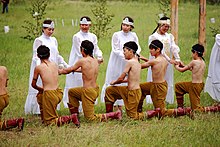

According to the 2021 Census, the ethnic composition was:[41]
- 469,348 Sakha (55.3%)
- 276,986 Russians (32.6%)
- 24,334 Evenks (2.9%)
- 13,233 Evens (1.6%)
- 11,203 Kyrgyz (1.3%)
- 7,169 Ukrainians (0.8%)
- 6,572 Buryats (0.8%)
- 5,620 Tajiks (0.7%)
Historical population figures are shown below:
| Ethnic group | 1926 Census | 1939 Census | 1959 Census | 1970 Census | 1979 Census | 1989 Census | 2002 Census | 2010 Census | 2021 Census1 | |||||||||
|---|---|---|---|---|---|---|---|---|---|---|---|---|---|---|---|---|---|---|
| Number | % | Number | % | Number | % | Number | % | Number | % | Number | % | Number | % | Number | % | Number | % | |
| Sakha | 235,926 | 81.6% | 233,273 | 56.5% | 226,053 | 46.4% | 285,749 | 43.0% | 313,917 | 36.9% | 365,236 | 33.4% | 432,290 | 45.5% | 466,492 | 49.9% | 469,348 | 55.3% |
| Dolgans | 0 | 0.0% | 10 | 0.0% | 64 | 0.0% | 408 | 0.0% | 1,272 | 0.1% | 1,906 | 0.2% | 2,147 | 0.3% | ||||
| Evenks | 13,502 | 4.7% | 10,432 | 2.5% | 9,505 | 2.0% | 9,097 | 1.4% | 11,584 | 1.4% | 14,428 | 1.3% | 18,232 | 1.9% | 21,008 | 2.2% | 24,334 | 2.9% |
| Evens | 738 | 0.3% | 3,133 | 0.8% | 3,537 | 0.7% | 6,471 | 1.0% | 5,763 | 0.7% | 8,668 | 0.8% | 11,657 | 1.2% | 15,071 | 1.6% | 13,233 | 1.6% |
| Yukaghir | 396 | 0.1% | 267 | 0.1% | 285 | 0.1% | 400 | 0.1% | 526 | 0.1% | 697 | 0.1% | 1,097 | 0.1% | 1,281 | 0.1% | 1,510 | 0.2% |
| Chukchis | 1,298 | 0.4% | 400 | 0.1% | 325 | 0.1% | 387 | 0.1% | 377 | 0.0% | 473 | 0.0% | 602 | 0.1% | 670 | 0.1% | 709 | 0.1% |
| Russians | 30,156 | 10.4% | 146,741 | 35.5% | 215,328 | 44.2% | 314,308 | 47.3% | 429,588 | 50.4% | 550,263 | 50.3% | 390,671 | 41.2% | 353,649 | 37.8% | 276,986 | 32.6% |
| Ukrainians | 138 | 0.0% | 4,229 | 1.0% | 12,182 | 2.5% | 20,253 | 3.0% | 46,326 | 5.4% | 77,114 | 7.0% | 34,633 | 3.6% | 20,341 | 2.2% | 7,169 | 0.8% |
| Tatars | 1,671 | 0.6% | 4,420 | 1.1% | 5,172 | 1.1% | 7,678 | 1.2% | 10.976 | 1.3% | 17,478 | 1.6% | 10,768 | 1.1% | 8,122 | 0.9% | 4,262 | 0.5% |
| Others | 5,260 | 1.8% | 10,303 | 2.5% | 14,956 | 3.1% | 19,770 | 3.0% | 32,719 | 3.8% | 59,300 | 5.4% | 48,058 | 5.1% | 46,124 | 4.9% | 49,070 | 5.8% |
| 1 146,918 people were registered from administrative databases, and could not declare an ethnicity. It is estimated that the proportion of ethnicities in this group is the same as that of the declared group.[42] | ||||||||||||||||||
Languages edit
The official languages are both Russian and Sakha, also known as Yakut, which is spoken by roughly half of the republic's population. In the 2021 census, 95% of Yakuts, 72% of Evenks and 60% of Evens declared Sakha as their native language.[43] The Sakha language is a member of the Turkic language family, belonging to the Siberian branch. It is closely related to the Dolgan language of the former Taymyr Dolgano-Nenets Autonomous Okrug.
The Sakha Republic is also home to many of the world's speakers of Tungusic languages, primarily of Evenki and Even. Additionally, Chukchi and the lects of the Yukaghir language family are spoken in the northeast.
| Ethnicity | Native language | ||
|---|---|---|---|
| Russian | Sakha | Other | |
| Russians | 99.4% | 0.4% | 0.2% |
| Yakuts | 5.0% | 95.0% | 0.0% |
| Evenks | 12.3% | 72.4% | 15.3% |
| Evens | 10.7% | 60.2% | 29.1% |
Religion edit
Before the arrival of the Russian Empire, the majority of the local population was Tengrist, similar to the other Turkic people of Central Asia, or in Paleoasian indigenous shamanism with both 'light' (community leading) and 'dark' (healing through spirit journey) shamans. Under the Russians, the local population was converted to the Russian Orthodox Church and required to take Orthodox Christian names, but in practice generally continued to follow traditional religions. During the Soviet era, most or all of the shamans died without successors.In the 1990s, a neopagan shamanist movement called aiyy yeurekhé was founded by the controversial journalist Ivan Ukhkhan and a philologist calling himself Téris.[46] This group and others cooperated to build a shaman temple in downtown Yakutsk in 2002.[47]

Currently,[when?] while Orthodox Christianity maintains a following (however, with very few priests willing to be stationed outside of Yakutsk), there is interest and activity toward renewing the traditional religions. As of 2008, Orthodox leaders described the worldview of the republic's indigenous population (or, rather, those among the population who are not completely indifferent to religion) as dvoyeverie (dual belief system), or a "tendency toward syncretism", as evidenced by the locals sometimes first inviting a shaman, and then an Orthodox priest to carry out their rites in connection with some event in their life.[48]
According to the Information Center under the President of Sakha Republic (Информационный центр при Президенте РС(Я)), the religious demography of the republic was as follows:[49] Orthodoxy: 44.9%, Shamanism: 26.2%, Non-religious: 23.0%, New religious movements: 2.4%, Islam: 1.2%, Buddhism: 1.0%, Protestantism: 0.9%, Catholicism: 0.4%.
According to a 2012 survey,[44] 37.8% of the population of Sakha adheres to the Russian Orthodox Church, 13% to Tengrism or Sakha shamanism, 2% to Islam, 1% are unaffiliated Christians, 1% to forms of Protestantism, and 0.4% to Tibetan Buddhism. In addition, 26% of the population deems itself atheist, 17% is "spiritual but not religious", and 1.8% follows other religions or did not give an answer to the question.[44]
Education edit
The most important facilities of higher education include North-Eastern Federal University (previously Yakutsk State University) and Yakutsk State Agricultural Academy.
Politics edit
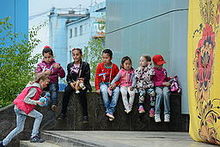
The head of government in Sakha is the Head (previously President). The first Head of the Sakha Republic was Mikhail Yefimovich Nikolayev.[50] As of 2021, the head is Aysen Nikolayev, who took office on May 28, 2018.
The supreme legislative body of state authority in Sakha is a unicameral State Assembly known as the Il Tumen. The government of the Sakha (Yakutia) Republic is the executive body of state authority.
The republic fosters close cultural, political, economic, and industrial relations with the independent Turkic states through membership in organizations such as the Turkic Council and the Joint Administration of Turkic Arts and Culture.[51][52][53]
Economy edit

At the same time, the level of poverty among the population remains high.[54]
The largest companies in the region include Alrosa, Yakutugol, Yakutskenergo, and Yakutia Airlines.[55]
Transportation edit
Water transport ranks first for cargo turnover. There are six river ports, two seaports (Tiksi and Zelyony Mys). Four shipping companies, including the Arctic Sea Shipping Company, operate in the republic. The republic's main waterway is the Lena River, which links Yakutsk with the rail station of Ust-Kut in Irkutsk Oblast.

Air transport is the most important for transporting people. Airlines connect the republic with most regions of Russia. Yakutsk Airport has an international terminal.
Two federal roads pass the republic. They are Yakutsk–Skovorodino (A360 Lena highway) and Yakutsk–Magadan (M56 Kolyma Highway).However, due to the presence of permafrost, use of asphalt is not practical, and therefore the roads are made of clay. When heavy rains blow over the region, the roads often turn to mud, sometimes stranding hundreds of travelers in the process.[56]
The Berkakit–Tommot railroad is currently in operation. It links the Baikal-Amur Mainline with the industrial centers in South Sakha. Construction of the Amur–Yakutsk Mainline continues northward; the railway was completed to Nizhny Bestyakh, across the river from Yakutsk, in 2013. Though this one-track railroad from Tommot to Nizhny Bestyakh is under temporary operation (30% of its full capacity), the federal agency for railways declared that this railroad would be in full operation in fall 2015.[needs update] Also the private company is now[when?] constructing the transport and logistics center in Nizhny Bestyakh.
Media edit
NVK Sakha (national broadcaster company Sakha, Национальная вещательная компания Саха, "Саха" көрдөрөр иһитиннэрэр тэрилтэтэ), the largest media company in the Republic of Sakha (Yakutia). The company owns dozens of TV channels in Yakutia, Russia, and other countries. The main broadcasting languages are Yakut, English, Russian and Evenk. It was founded in 1992 after the collapse of the USSR. 70% of the shares are owned by the Russian VGTRK, 25% are owned by Yakutia, and 5% are in free float. NVK Sakha owns its own animation and film production studios, and some music studios. Since 2018, it has also been streaming 24/7 on YouTube.
Culture edit

Points of interest in the city of Yakutsk include:
- the State Russian drama theatre named after Alexander Pushkin
- the Sakha Theater named after Platon Oyunsky
- the State Academic Opera and Ballet Theatre named after D. K. Sivtsev
- Suorun Omoloon, the Young Spectator's Theatre
There are a number of museums as well. These include the National Fine Arts Museum of Sakha, the Museum of Local Lore and History named after E. Yaroslavsky, and the Khomus Museum and Museum of Permafrost. In September 2020, the Gagarin Center for Culture and Contemporary Art was opened in the Gagarin District of Yakutsk.[57]
The Yakuts have fully preserved their native language, which differs significantly from other Turkic languages by the presence of a layer of unique Paleo-Asiatic vocabulary. The Yakut language has a developed literary tradition with many styles and genres, and the ancient Sakha epic Olonkho is recognized by UNESCO as a masterpiece of the oral and intangible heritage of humanity.[58]
In the 2010s, a movie boom began in Yakutia. The local film industry was labelled "Sakhawood".[59]
National days edit
- April 27: Republic Day
- June 21: Yhyakh festival (also known as Sakha New Year)
See also edit
Explanatory notes edit
- ^
- Russian: Якутия, romanized: Yakutiya, IPA: [jɪˈkutʲɪjə]
- Yakut: Саха Сирэ
- ^
- Russian: Республика Саха (Якутия), romanized: Respublika Sakha (Yakutiya), IPA: [rʲɪsˈpublʲɪkə sɐˈxa jɪˈkutʲɪjə]
- Yakut: Саха Өрөспүүбүлүкэтэ, romanized: Saxa Öröspüübülükete, IPA: [saˈxa øɾøsˈpyːbylykete]
References edit
Citations edit
General and cited references edit
- Верховный Совет Республики Саха (Якутия). 4 апреля 1992 г. «Конституция (основной закон) Республики Саха (Якутия)», в ред. Конституционного закона №581-З 53-IV от 22 июля 2008 г. (Supreme Council of the Sakha (Yakutia) Republic. April 4, 1992 Constitution (Basic Law) of the Sakha (Yakutia) Republic, as amended by the Constitutional Law #581-Z 53-IV of July 22 2008. ).
External links edit

- Official website of the government of Sakha Republic (in Russian)



